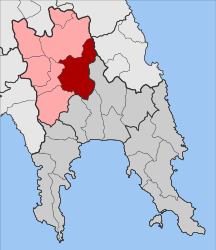Therapnes
Therapnes (Greek: Θεράπνες) is a municipal unit (dimotiki enotita) of the municipality (dimos) of Sparti within the regional unit (perifereiaki enotita) of Laconia in the region (perifereia) of Peloponnese, one of 13 regions into which Greece has been divided.[2] The municipal unit has an area of 261.711 km2.[3] Before 2011 Therapnes was a Demos of Lakonia according to Law 2539 of 1997, the Kapodistria Plan. Its seat was Gkoritsa, which now has no such status. Within its borders lies the ancient town of Therapne.
Therapnes Θεράπνες | |
|---|---|
 Therapnes Location within the regional unit  | |
| Coordinates: 37°05′N 22°33′E | |
| Country | Greece |
| Administrative region | Peloponnese |
| Regional unit | Laconia |
| Municipality | Sparti |
| • Municipal unit | 261.7 km2 (101.0 sq mi) |
| Population (2011)[1] | |
| • Municipal unit | 2,304 |
| • Municipal unit density | 8.8/km2 (23/sq mi) |
| Time zone | UTC+2 (EET) |
| • Summer (DST) | UTC+3 (EEST) |
| Vehicle registration | AK |
Both before the Kallikratis law and after it, Therapnes was composed of the same eight Local Communities (topiki koinotita), the lowest level of the hierarchy: Agioi Anargyroi (formerly Zouraina), Agrianoi, Gkoritsa, Kalloni, Kefalas, Platana, Skoura and Chrysafa. The population of Therapnes in the 2011 census, conducted by the Ministry of the Interior, was 2,304.[1]
Villages
- Goritsa or Gortsoupolis, as it is called by the Athenian residents of Goritsa
- Hrysafa
- Zoupena
- Perepni
- Skoura
- Platana
- Zagana
- Tsintzina
- Agrianoi
Geography
Therapnes covers the hill country on the east bank of the Eurotas River northeast to the slopes of Mt. Parnon. The Local Communities are each centered around a village. Each village has a history of its own, but the basis making Therapnes a distinct unit is the presence of the ruins of ancient Therapne, a Bronze Age city that stood on a ridge on the left bank of the Eurotas River, overlooking the Eurotas Valley and the site of Dorian Sparta, today's city of Sparti. The villages of Therapnes are in essence on or near the old road that led from Therapne or Dorian Sparta over Platanaki Pass just south of the main peak of Parnon to what is now South Kynouria in the eastern foreland of Parnonas and the Argolic and Myrtoan Gulfs. The pass connected Bronze Age Mycenae with its sister kingdom, Lacedaemon.
The ridge has an elevation of about 500 metres (1,600 feet). Its eminence over the river is about 230 metres (750 feet). From the top of the ridge the valley below appears as a sunken bowl between Mount Taygetus and Therapne, hence the Homeric epithet "Hollow Lacedaemon." There is no standard modern name of the ridge. Some refer to it as Mount Menelaus after the Menelaion, a temple that stood on the ridge, or the Menelaus Ridge, and others Mount Therapne.
Bronze Age Therapne
Mycenaean town
Therapne was among the most ancient communities of Greece. During the Bronze Age there was a large settlement at Therapne, with shrines to Menelaus and Helen.[4]
Therapne in legend
In mythological terms, it was said to derive its name from a nymph Therapne, daughter of Lelex, and Castor and Pollux were thought to have been born there.[5] While Pausanias writes that Therapne has "a Temple of Menelaos" (3.19.9), Herodotus (6.61) calls the same building the temple of Helen.[6]
References
- "Απογραφή Πληθυσμού - Κατοικιών 2011. ΜΟΝΙΜΟΣ Πληθυσμός" (in Greek). Hellenic Statistical Authority.
- η Βουλή (11 August 2010), "ΤΕΥΧΟΣ ΔΕΥΤΕΡΟ", ΝΟΜΟΣ ΥΠ’ΑΡΙΘ. 3852: Νέα Αρχιτεκτονική της Αυτοδιοίκησης και της Αποκεντρωμένης Διοίκησης − Πρόγραμμα Καλλικράτης (PDF) (in Greek), ΕΦΗΜΕΡΙΣ ΤΗΣ ΚΥΒΕΡΝΗΣΕΩΣ ΤΗΣ ΕΛΛΗΝΙΚΗΣ ΔΗΜΟΚΡΑΤΙΑΣ, p. 17434. Part 2 of the Kallicratis Plan law, No. 3852, publishing a table of all the official communities of Greece arranged in hierarchical order. The lowest-level populations are from the Census of 2001. All higher-level populations are the sums of the appropriate lower-level populations.
- "Population & housing census 2001 (incl. area and average elevation)" (PDF) (in Greek). National Statistical Service of Greece.
- Sarah Pomeroy et al. (ed.), Ancient Greece, 2nd ed. (Oxford UP, 2008), p. 154.
- John Lemprière, A Classical Dictionary (T. Cadell, 1831), p. 768.
- Jennifer Lynn Larson, Greek Heroine Cults (Univ of Wisconsin Press, 1995: ISBN 0-299-14370-8), p. 81.
External links
- Mixalis, Leimonitis. "Agrianoi". Panoramio. Retrieved 29 August 2011.
- EEconomos. "Chryssafa". Panoramio. Retrieved 29 August 2011.
- Mixalis, Leimonitis. "Goritsa". Panoramio. Retrieved 29 August 2011.
- Apostoleli, Elpida. "Menelaion". Panoramio. Retrieved 29 August 2010.
- Aristotelis, Tzanakos. "Zoupena (now Agrioi Anargyroi)". Panoramio. Retrieved 29 August 2011.
- "The Menelaion [at ancient Therapne]". Regional Guide of Peloponnese. Information Society in Greece. Retrieved 29 August 2011.